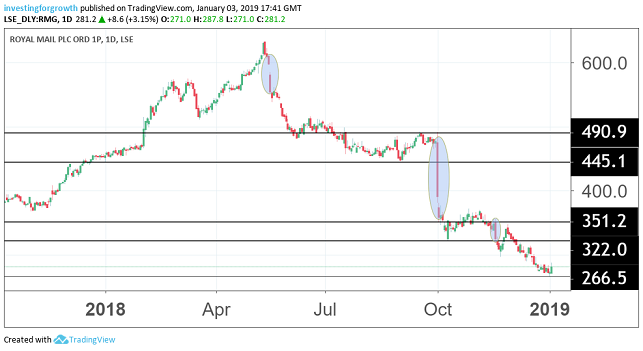Stockwatch: Time to buy Royal Mail shares?
4th January 2019 09:43
by Edmond Jackson from interactive investor
Still near a record low, Royal Mail, its 9% dividend yield and big discount to net assets are starting to interest contrarian investors. Companies analyst Edmond Jackson gives his view.

Ejected from the FTSE 100 index last month after plunging in the autumn, have shares in postal/delivery services group Royal Mail over-sold?
Finding support just below 270p, at around 280p currently Royal Mail is down 56% from its mid-2018 peak of 631p, 15% from its October 2013 flotation price of 330p a share, and 34% below last September’s balance sheet net assets. Buyers are likely tempted by the hope of a 9%-plus yield and will recall that the chief executive snapped up £941,000 worth of shares at prices of 318p down to 290p late last year - as if he considers the plunge excessive.
Profit warning meant an autumnal whirlwind
Royal Mail is an accentuated example of hype turning to alarm, that characterised equities in 2018. It soared from 370p to 630p by mid-year then slumped; having previously traded above 600p in 2014 but closed that year below 400p. It then went volatile sideways with highs of 520-540p, as if the market was in two minds about whether sustainable growth is in prospect, or slow death as mail diminishes further and competition intensifies for parcels.
A plunge from 480p came after a 1 October profit warning that cut guidance for adjusted operating profit for the year to end-March 2019, to a £500-£550 million range versus £694 million last year.
Operations were broadly as expected: guidance for letter volumes remains down about 4-6% a year, but was down 7% in Royal Mail's first half due to tighter EU regulations on exploiting personal information, which cut junk mail. Parcels were doing well, up 6% with revenue and volume growth higher on the last financial year. The financial hit came from productivity improvement of only 0.1% versus a 2-3% target; which, though disappointing, ought to be fixable.

Source: TradingView (*) Past performance is not a guide to future performance
For 2019, the chief executive promised:
"a clearer focus on financial performance and management accountability", with a first capital markets day in March "when we will share more detail about our direction for the first five years."
With brokers having forecast £550 million-plus pre-tax profit and earnings per share (EPS) of about 38p (see table) I'd slash those numbers to roughly £400 million and 28p, implying a current price/earnings (PE) ratio of around 10 times. A circa 25p dividend might just hold in respect of the current financial year, though a disciplined investment approach would wait to see how performance/finances evolve.
Cash flow record and yield hopes start to lend support
The chief question is whether there's a worthwhile cash-generative business: maybe at lower expectations than of recent years but which can still support useful payouts. Earnings cover accords to what extent of "normalised" view you take; but the directors like to boast cash generative strengths and, indeed, the table shows a track record of cash flow per share substantially greater than earnings.
Last November's interim results' cash flow statement - albeit a snapshot in time - was less affirmative: despite EBITDA rising 47% to £375 million, working capital movements especially a decrease in payables meant the net cash inflow from operations whittled down to £38 million against £250 million the previous year.
It would appear management is addressing the trade creditor/debtor imbalance I discuss below regarding the balance sheet. In the first half year the dividend-related cash payout was £162 million which helps explain a decrease in cash held to £218 million; hence, with 1,000 million ordinary shares issued, a 25p dividend would cost £250 million for the full year and is why the sense of a 9% yield flags risk.
| Royal Mail - financial summary | |||||||
|---|---|---|---|---|---|---|---|
| year ended 31 Mar | |||||||
| 2014 | 2015 | 2016 | 2017 | 2018 | 2019 | 2020 | |
| Turnover (£ million) | 9,357 | 9,328 | 9,251 | 9,776 | 10,172 | ||
| IFRS3 pre-tax profit (£m) | 1,664 | 400 | 267 | 335 | 212 | ||
| Normalised pre-tax profit (£m) | 1,884 | 515 | 427 | 478 | 355 | 553 | 550 |
| Operating margin (%) | 20.8 | 5.8 | 4.7 | 5.0 | 3.6 | ||
| IFRS3 earnings/share (p) | 128 | 32.5 | 21.4 | 27.3 | 27.3 | ||
| Normalised earnings/share (p) | 148 | 44.2 | 36.7 | 40.8 | 10.3 | 38.3 | 37.9 |
| Price/earnings multiple (x) | 26.5 | 7.1 | 7.2 | ||||
| Historic annual average P/E (x) | 3.3 | 9.1 | 10.9 | 12.1 | 7.7 | ||
| Cash flow/share (p) | 73.3 | 74.4 | 75.6 | 74.7 | 90.6 | ||
| Capex/share (p) | 37.7 | 38.1 | 42.3 | 35.4 | 32.6 | ||
| Dividend per share (p) | 20.0 | 21.0 | 22.1 | 23.0 | 24.0 | 25.0 | 26.0 |
| Dividend yield (%) | 8.6 | 8.9 | 9.3 | ||||
| Covered by earnings (x) | 2.2 | 1.7 | 1.8 | 1.3 | 1.5 | 1.5 | |
| Net tangible assets per share (p) | 200 | 350 | 380 | 411 | 350 |
Source: Company REFS Past performance is not a guide to future performance
Issues around 424p a share net asset value
Like most boards, Royal Mail likes to profess a "strong" balance sheet. Last 23 September, and with the number of shares issued a convenient 1,000 million, deducting £1,106 million goodwill/intangibles from £4,241 million net assets derived 313.5p net tangible assets per share, as if the ongoing drop in market price is truly buttressed. A couple of things concern me about this and may explain the extent of drop.
Firstly, within non-current assets, £2,055 million constitutes a pension fund surplus which appears to at least support such liabilities for a good many years but is nothing a management can get its hands; the pension is all c/o trustees. So whichever way you look at net assets, pretty much half is a pension fund surplus.
Secondly, and a pet gripe of mine, £1,774 million trade payables compare with £1,250 million trade receivables, explaining a weak current ratio (of current assets to current liabilities) of 0.76. I surmise this is why the interim cash flow statement records (significantly in context) a £210 million decrease in payables; that Royal Mail is steadily improving woeful payment terms, but a backlog lingers.
Various reasons can explain why payables/receivables don't match, but with a £103 million decrease in payables also in respect of 2017, I’d deduct at least £500 million from net assets as money due.
Strikes remain a potential long-term risk
In October 2017, a 48-hour walkout and also the threat of industrial action during Black Friday week, was only prevented by a high court injunction making action unlawful until any mediation process had been exhausted.
While Royal Mail employees have accepted changes to their pensions and may have kept shares now diminished in value, they have also seen its chief executive enjoy £6 million to compensate him for moving from another part of the group, on top of £2.7 million annual pay.
- Could Royal Mail really fall another 30%?
- Royal Mail crashes after shock profits warning
- Are high yielder Royal Mail's results any good
So, if inflation rises in a post-Brexit UK, Royal Mail could again be pressured by the communication workers union, possibly compromising management’s ability to wrest efficiencies if letters’ volumes materially decline and parcels' competition rises. Hardly a short-term risk, but if the Tories fall apart and a Labour government ensues, trade unions would feel emboldened.
Shadow chancellor John McDonnell has also specified Royal Mail when referring to industry sectors Labour plans to re-nationalise. In 2017 he said this would be achieved by acquiring enough shares to restore majority control i.e. 50.1%, which after this extent of market slump might be considered a welcome prop. Quite where Labour would get the money I don’t know: I’d pay more attention to latent worker discontent.
A 4.52% overall short position, yet scope to be positive
Short-selling probably accentuated the 2018 drop and, within those short positions disclosed (representing over 0.5% of Royal Mail’s issued share capital), three hedge funds raised their positions later last December, two reduced and two held steady, thereby reflecting a mix of views that it’s possible to take on Royal Mail currently.
Letters' decline and parcels' growth has nearly balanced revenues, and Next’s declaring 15% growth in online sales for the last two months of 2019 implies opportunities for parcel handlers.
Now, can Royal Mail management impress with its March presentation, and will the dividend be sustained? If they can wrest efficiencies then potentially so, otherwise a cut implies a more typical 4-5% yield. Debt looks plenty manageable however, so sub-300p the stock is interesting for contrarians who could take heart a dividend cut is effectively priced in. Speculative Buy.
*Horizontal lines on charts represent levels of previous technical support and resistance. Trendlines are marked in red.
Edmond Jackson is a freelance contributor and not a direct employee of interactive investor.
These articles are provided for information purposes only. Occasionally, an opinion about whether to buy or sell a specific investment may be provided by third parties. The content is not intended to be a personal recommendation to buy or sell any financial instrument or product, or to adopt any investment strategy as it is not provided based on an assessment of your investing knowledge and experience, your financial situation or your investment objectives. The value of your investments, and the income derived from them, may go down as well as up. You may not get back all the money that you invest. The investments referred to in this article may not be suitable for all investors, and if in doubt, an investor should seek advice from a qualified investment adviser.
Full performance can be found on the company or index summary page on the interactive investor website. Simply click on the company's or index name highlighted in the article.
Disclosure
We use a combination of fundamental and technical analysis in forming our view as to the valuation and prospects of an investment. Where relevant we have set out those particular matters we think are important in the above article, but further detail can be found here.
Please note that our article on this investment should not be considered to be a regular publication.
Details of all recommendations issued by ii during the previous 12-month period can be found here.
ii adheres to a strict code of conduct. Contributors may hold shares or have other interests in companies included in these portfolios, which could create a conflict of interests. Contributors intending to write about any financial instruments in which they have an interest are required to disclose such interest to ii and in the article itself. ii will at all times consider whether such interest impairs the objectivity of the recommendation.
In addition, individuals involved in the production of investment articles are subject to a personal account dealing restriction, which prevents them from placing a transaction in the specified instrument(s) for a period before and for five working days after such publication. This is to avoid personal interests conflicting with the interests of the recipients of those investment articles.